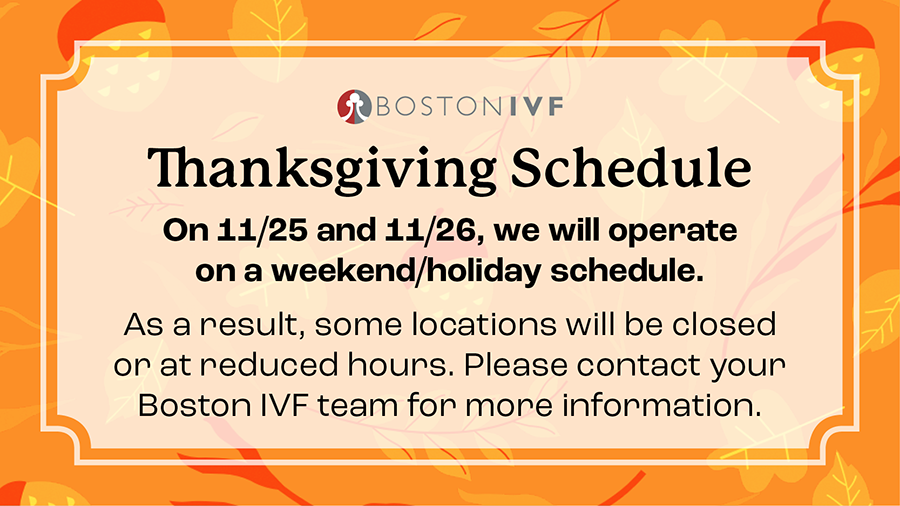IVF success rates are intimately tied with embryo selection; that is, choosing to implant the embryo with the highest probability of leading to a successful, healthy pregnancy and birth.
Elective Single Embryo Transfer (eSET) is an option to implant one single embryo into a woman's uterus, rather than a few. For those patients with a good prognosis for success who also meet the recommended guidelines for treatment, eSET provides the same success rate as IVF.
HOW IT HELPS
The biggest advantage of eSET is a greatly reduced risk of multiple births (twins, triplets, etc.). Our goal is always to achieve one singleton pregnancy per cycle to ensure a healthy baby and happy parents. One key component of working to achieve this goal is by using embryos conservatively.
At Boston IVF, we educate our prospective parents to help them make the best, most informed decisions in regard to their treatment. If IVF is a part of your fertility plan, your doctor will be ready to discuss whether eSET is the right option for you on your path toward growing your family.
eSET BACKGROUND
Traditionally, IVF has involved the transfer of multiple embryos in an attempt to improve success rates. The theory was that the more embryos transferred, the more likely an embryo would implant and result in pregnancy. Recent research, however, plus improvements in fertility treatments, have shown this is not the case.
Today, with better techniques available to grow and select the best quality embryos, the decision to decrease the amount of embryos transferred results in greatly decreasing the risk of multiple births, therefore increasing the chance of a successful pregnancy.
WHAT IS eSET?
A single-embryo transfer (eSET) is an IVF technique which allows our team to identify and implant one high-quality embryo into a woman's uterus.
RISKS OF TWINS AND TRIPLETS
While some patients may perceive ‘multiples’ as a time-saving and safe outcome in an IVF cycle, there are a number of complications to be mindful of, for both the baby and mother. Transferring multiple embryos often leads to multiple pregnancies, which can result in:
- higher risks of miscarriage
- higher chances of premature birth
- preeclampsia
- gestational diabetes
- higher rates of C-section delivery
- postpartum depression
EXPERIENCE MATTERS
With more than 500 single embryo transfers performed in 2015, our national fertility network and local center has the expertise that enables us to consistently achieve high success rates with a low multiple birth rate.
Based on data collected from thousands of treatment cycles over many years of experience at Boston IVF (and confirmed by many other studies in the US and worldwide) we know that when one faces a choice between eSET or multiple embryo transfers, the best and safest answer is often eSET.
"One size does not fit all" when it comes to the number of embryos we transfer.
Our team utilizes a customized approach to patient care that is designed to optimize outcomes for each patient. eSET is an option for all patients that have at least one chromosomally normal embryo, as identified through PGS.
eSET is recommended for women:
- younger than 35 years of age
- beginning their first IVF cycle
- with prior IVF success
- with a large number of high-quality embryos
- who have embryos available for freezing
- who are recipients of donor eggs
The first step in deciding if eSET is right for you is to discuss the option with your fertility doctor at Boston IVF.
SELECTING AN EMBRYO
High-quality eggs produce high-quality embryos, which, therefore, helps the embryo to continue to grow and ‘stick’ once inside the uterus. Embryos must be strong enough to survive the early stages of development. As a woman ages, her ability to produce high-quality eggs begins to diminish, which, in turn, effects the quality of her embryos and, ultimately, the success of her pregnancy.
To choose the highest-quality embryo for transfer, the laboratory grades each one based on its appearance. This assessment includes a number of factors, including the number and size of the cells and the rate of development. Improved laboratory conditions now allow us to grow embryos to day 5 of development, the blastocyst stage.
These embryos, left to develop for five days, contain hundreds of cells. If an embryo reaches the blastocyst stage, we know it is a superior, healthy embryo and has a better chance of implanting successfully. While no method can reliably predict which embryo will produce live offspring (because so many other components factor into birth rate), eSET does offer an opportunity to select the embryo most likely to grow inside the uterus.
eset PROCESS
The process of eSET is very similar to that of conventional IVF. First, you begin taking hormones to increase egg production. Once the eggs have matured, they are collected and mixed in the laboratory with sperm.
After the fertilization process, eSET identifies the healthiest embryo and transfers that single embryo to the woman's uterus. The lab freezes any other healthy embryos for future use.







